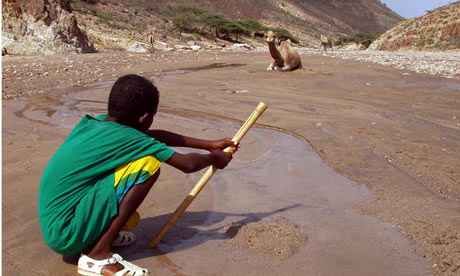Food aid is needed desperately - but ultimately it is not the answer
Underneath the high visibility famine lies an age-old way of living that has been disrupted by a modern world system

The famine in the Horn of Africa is linked to the end of the nomadic way of raising herds in the region. Photograph: Ed Harris/Reuters
The images of Africans affected by the drought in Somalia, Ethiopia and Kenya paint a grim picture – thousands of people are again in desperate need and are being provided with food aid to allow them to survive. But what the photographs fail to show is the reason why so many people have reached this state of destitution. Underneath the high visibility famine lies an age-old and sustainable way of living that has been disrupted by a modern world system, and whose ability to adapt to the cycle of drought has beenseverely undermined. An estimated 20 million people live in the dryland areas of the Horn of Africa; nomads, or pastoralists, who own livestock and feed themselves, their communities and the regional economy with milk, meat and other livestock products. Pastoralists have lived in the harsh and erratic dryland environments of the Horn for centuries, surviving its regular and repeated cycle of droughts through their unique production strategy that depends on mobility. While a farmer waits for the rain to arrive, a pastoralist moves to where the rain has already been – feeding their camels, cows, sheep or goats on the new grazing opportunities and accessing the water sources. Complex social systems that cross national borders, and the reserving of key areas of land for drought periods, have traditionally ensured that pastoralists have adapted to the extreme climatic variability they face. But in recent decades vast areas of the pastoralist land in the Horn of Africa have been taken over by agriculture and large-scale commercial farms – often in the key strategic riverine areas previously reserved for times of drought. This has undermined the whole system and reduced yields of milk and meat. When livestock are forced to stay in the same place, they also become more susceptible to disease. With the loss of so much of their grazing areas many pastoralists now prefer to herd camels, which can survive on the remaining degraded habitats, need less frequent watering and can also feed at night when it is cooler. The conflict and insecurity of the region further restricts livestock mobility and affects the long-distance livestock trade, particularly from Somalia. In periods of drought, when milk yields are low, pastoralists will sell their livestock for grain, but as far as possible will always retain a core breeding stock for building up their herds when the situation improves. When food prices rocket and livestock prices plummet at the same time, many will lose all their assets. Without any social support they are forced to drop out of pastoralism altogether and become a drain on the state rather than a contribution to it.More....






 7/20/2011 10:30:00 PM
7/20/2011 10:30:00 PM
 live news
live news












0 commentaires:
Post a Comment